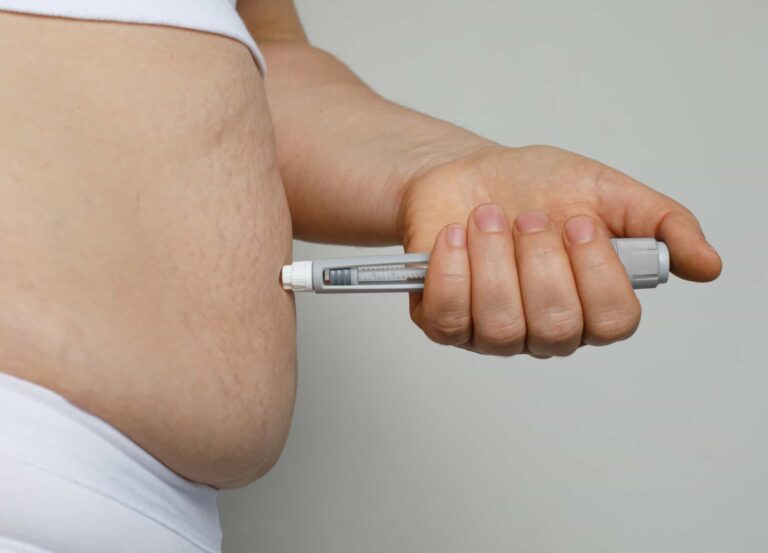Changing the appearance of your midsection is not easy. From stubborn pockets of fat that just won’t go away to sagging skin that can’t bounce back to its original appearance, it can sometimes feel like the stomach is one area of the body that’s impossible to change. Oftentimes, no amount of exercise or dieting, no number of nonsurgical options—like Emsculpt or CoolSculpting—can get us the streamlined waist we’ve been after, which is when surgery becomes a more appealing option.
Liposuction and abdominoplasty—better known as tummy tuck—are two of the more common choices for improving the appearance of the abdominal area. However, it can be difficult to know which procedure is right for you without understanding the key differences between the two. We tapped New York City board-certified plastic surgeon Dr. Darren Smith and Las Vegas board-certified plastic surgeon Dr. Jeffrey Roth for a full breakdown of each surgery.
What is the difference between a tummy tuck and liposuction?
While the goal of abdominal liposuction and that of a tummy tuck are generally similar—to alter the appearance of the midsection—they’re two very different procedures. “A tummy tuck, or abdominoplasty, is a procedure designed to improve the contour of the abdomen,” says Dr. Smith. It includes removal of tissue—specifically fat and skin—and surgically stitching together separated abdominal muscles in order to sculpt the midsection. Tummy tucks address muscle separation issues, especially for patients who are post-pregnancy, to create a smoother, firmer abdominal area that’s free of any bulging or excess skin.
On the other hand, liposuction’s main purpose is fat removal. “Liposuction is the removal of fat cells using a cannula instrument—[which is a long, thin tube]—that is attached to a suction machine,” says Dr. Roth. The fat cells are physically removed from the body by suction, through the cannula, and are deposited into a canister. With liposuction, surgeons can remove fat from virtually any area of the body—not just the abdomen—and the procedure is often paired with a tummy tuck for those who have stretched out skin [in the abdominal area] that won’t retract once fat is removed.
Related: 10 Doctors Give Their Best Liposuction Advice, in 10 Words or Less
What happens during a tummy tuck versus liposuction?
The surgical process for a tummy tuck and liposuction are very different.
Tummy tuck
Warning: graphic content
“A tummy tuck addresses [muscle, fat, and skin],” says Dr. Smith. Tummy tucks are performed under general anesthesia and, if paired with liposuction, begin with fat removal in the area. “Then a long, low incision is made across the waist, ideally so it can be hidden below the panty line,” explains Dr. Smith. He then raises excess skin and fat off the abdominal wall, as a compound unit of tissue called a “flap,” and also creates an incision around the belly button to separate it from the skin and fat that is being lifted. “The [abdominal muscles] are sutured together to treat [muscle] separation, or “rectus diastasis,” Dr. Smith explains of the next step. These muscles are often stretched and separated due to pregnancy or dramatic weight changes. Stitching muscles back together creates an internal corset for the patient and restores tightness to the area. “Then excess skin and fat are excised from the flap we have raised, the edges of the abdomen are closed, and the belly button is sutured in place in the flap we raised.” says Dr. Smith.
Liposuction
Liposuction, on the other hand, uses a completely different surgical technique on the abdomen and doesn’t require the same incisions. According to Dr. Smith, liposuction can be performed under local anesthesia (the site of surgery is numb, but the patient is awake), IV sedation (the patient is awake but numb and less aware of their surroundings), or general anesthesia (the patient is asleep). Three to four millimeter incisions are made in hidden locations and a saline, epinephrine, and lidocaine solution is introduced through the incisions, numbing and constricting blood vessels in order to reduce bleeding. “Fat is then suctioned through these same incisions with a cannula,” says Dr. Smith, adding that this is done until the desired amount (usually up to five liters, the maximum considered to be safe to remove in one setting) of fat removal and body slimming has been achieved before the tiny incisions are sutured closed.
What are the potential complications?
The complications for both liposuction and tummy tuck are generally the same as with any surgery, and they include bleeding and infection. For tummy tuck procedures, hematoma—bleeding in the area between muscle and skin—and wound complications, which include drainage or opening of abdominal skin edge, are possible. “This is more common in smokers, nicotine users, and high-BMI patients,” says Dr. Roth, adding that pulmonary thromboembolism (blood clot in the lung) is also a rare risk. It’s important to note that one 2015 study found that tummy tuck procedures have a higher complication rate than other plastic surgeries, reporting 3% versus 1.5%. The procedure also has a higher mortality rate than do many other plastic surgeries, generally ranging from 0.02% to 0.16%.
When it comes to liposuction, complications can also include possible perforation of an organ via cannula. It is also possible to experience thermal burns (which can leave scarring) when undergoing laser lipo or ultrasound-assisted lipo. More serious complications include pulmonary thromboembolism, fat embolism, and pulmonary edema (fluid buildup in the lungs). Pulmonary thromboembolism (which is more common after surgery due to increased clotting and immobility) is responsible for 23% of deaths in patients who undergo liposuction surgery. A fat embolism, which is when particles of fat get into the bloodstream, can also be potentially fatal if the fat particles travel to the heart or lungs. While these complications are rare, they should be discussed with your doctor before undergoing the surgery.
Since liposuction addresses only fat removal, not skin laxity, a common issue post-procedure for patients with poor elasticity is that skin in the treated area won’t retract into a tighter form, leaving loose skin behind. While this is not a complication, it is a potential outcome of the surgery, which is why patients who experience this will typically seek out a tummy tuck, to remove the excess skin for a tighter appearance.
Related: High-Tech to High-Def—How Popular Tools and Techniques Are Reshaping Liposuction
What is the recovery like for each procedure?
“In general, you can be back at work 48 hours after liposuction, but you may be sore for a couple weeks,” says Dr. Smith. However, Dr. Roth says that many patients sometimes take longer to recover and choose to head back to work after 7 to 10 days, and they typically have to wear a compression garment for about six weeks post-surgery, to reduce swelling. After about five days, patients can start going back to the gym for light exercise.
The recovery process for a tummy tuck is much more extensive than from liposuction, since it’s more invasive. “A tummy tuck requires a solid two weeks off work,” says Dr. Smith. “Often, drains will be used [to reduce fluid buildup] and usually are removed in a week or two,” adds Dr. Roth. Dr. Smith advises his patients to do light walking during the first week post-procedure but to avoid any exertion. Frequently, patients walk slightly bent over for the first week because the abdomen is so tight, but that tends to go away after a few days. After about five weeks, patients can return to normal activities.
Who is a good candidate for each procedure?
For both procedures, doctors recommend that patients be in good health before opting for surgery. When it comes to liposuction, the ideal candidate is someone who is in their ideal weight range but has small deposits of fat where they want the bulk reduced and area slimmed. Patients should also have good skin laxity so that their skin will tighten up post fat removal.
“If there is skin laxity or rectus diastasis, tummy tuck is the way to go,” says Dr. Smith. While it also removes fat, muscle separation and loose skin should be the patient’s main concern when choosing a tummy tuck. Patients must be willing to accept a larger scar post-procedure, since the incisions are much larger than those created in liposuction. Doctors also recommend that patients be finished having children before they undergo this procedure, because giving birth can increase the chance that patients will need a revision surgery to retighten the midsection.
How much does each surgery cost?
According to RealSelf data, there’s a slight difference in the cost between the two procedures. Liposuction costs an average of $6,100, while a tummy tuck costs an average of $8,200. These prices can change though, depending on the cost of living in your region, your surgeon’s expertise, the complexity of your surgery, and whether other procedures are performed as add-ons during your procedure. Neither surgery is typically covered by health insurance plans.











